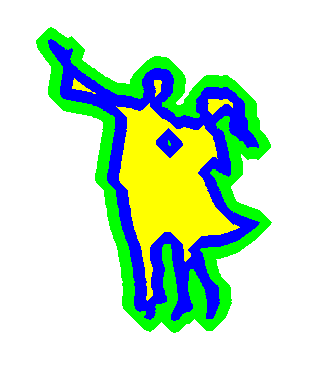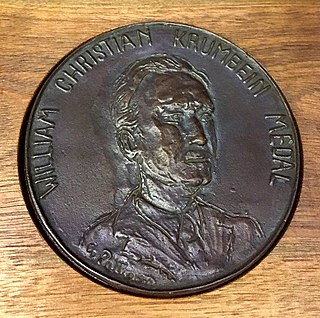Geostatistics is a branch of statistics focusing on spatial or spatiotemporal datasets. Developed originally to predict probability distributions of ore grades for mining operations, it is currently applied in diverse disciplines including petroleum geology, hydrogeology, hydrology, meteorology, oceanography, geochemistry, geometallurgy, geography, forestry, environmental control, landscape ecology, soil science, and agriculture. Geostatistics is applied in varied branches of geography, particularly those involving the spread of diseases (epidemiology), the practice of commerce and military planning (logistics), and the development of efficient spatial networks. Geostatistical algorithms are incorporated in many places, including geographic information systems (GIS).

Mathematical morphology (MM) is a theory and technique for the analysis and processing of geometrical structures, based on set theory, lattice theory, topology, and random functions. MM is most commonly applied to digital images, but it can be employed as well on graphs, surface meshes, solids, and many other spatial structures.

In statistics, originally in geostatistics, kriging or Kriging, also known as Gaussian process regression, is a method of interpolation based on Gaussian process governed by prior covariances. Under suitable assumptions of the prior, kriging gives the best linear unbiased prediction (BLUP) at unsampled locations. Interpolating methods based on other criteria such as smoothness may not yield the BLUP. The method is widely used in the domain of spatial analysis and computer experiments. The technique is also known as Wiener–Kolmogorov prediction, after Norbert Wiener and Andrey Kolmogorov.
Danie Gerhardus Krige was a South African statistician and mining engineer who pioneered the field of geostatistics and was professor at the University of the Witwatersrand, Republic of South Africa. The technique of kriging is named after him. Krige's empirical work to evaluate mineral resources was formalised in the 1960s by French engineer Georges Matheron.
In spatial statistics the theoretical variogram, denoted , is a function describing the degree of spatial dependence of a spatial random field or stochastic process . The semivariogram is half the variogram.
In mathematical morphology and digital image processing, a morphological gradient is the difference between the dilation and the erosion of a given image. It is an image where each pixel value indicates the contrast intensity in the close neighborhood of that pixel. It is useful for edge detection and segmentation applications.

Jean Paul Frédéric Serra is a French mathematician and engineer, and known as one of the co-founders of mathematical morphology.
48.404°N 2.694°ECentre de Morphologie Mathématique is a research center of the École des Mines de Paris, France, devoted to the research and promotion of mathematical morphology. It was created in 1968 as a result of the works of Georges Matheron and Jean Serra, who were hired as its first director and assistant director, respectively.

In mathematical morphology, granulometry is an approach to compute a size distribution of grains in binary images, using a series of morphological opening operations. It was introduced by Georges Matheron in the 1960s, and is the basis for the characterization of the concept of size in mathematical morphology.
Pedometric mapping, or statistical soil mapping, is data-driven generation of soil property and class maps that is based on use of statistical methods. Its main objectives are to predict values of some soil variable at unobserved locations, and to access the uncertainty of that estimate using statistical inference i.e. statistically optimal approaches. From the application point of view, its main objective is to accurately predict response of a soil-plant ecosystem to various soil management strategies—that is, to generate maps of soil properties and soil classes that can be used for other environmental models and decision-making. It is largely based on applying geostatistics in soil science, and other statistical methods used in pedometrics.
In applied statistics and geostatistics, regression-kriging (RK) is a spatial prediction technique that combines a regression of the dependent variable on auxiliary variables with interpolation (kriging) of the regression residuals. It is mathematically equivalent to the interpolation method variously called universal kriging and kriging with external drift, where auxiliary predictors are used directly to solve the kriging weights.

The International Association for Mathematical Geosciences (IAMG) is a nonprofit organization of geoscientists. It aims to promote international cooperation in the application and use of mathematics in geological research and technology. IAMG's activities are to organize meetings, issue of publications on the application of mathematics in the geological sciences, extend cooperation with other organizations professionally concerned with applications of mathematics and statistics to the biological sciences, earth sciences, engineering, environmental sciences, and planetary sciences. IAMG is a not for profit 501(c)(3) organization.
The Georges Matheron Lecture Series is sponsored by the International Association for Mathematical Geosciences (IAMG) to honor the legacy of the French engineer Georges François Paul Marie Matheron, known as the founder of geostatistics and a co-founder of mathematical morphology. The Georges Matheron Lecture is given by a scientist with proven research ability in the field of spatial statistics or mathematical morphology. It is presented annually if an eligible and worthy nominee is found. The first recipient of the award was Jean Serra, for a long time a scientists with the Centre of Mathematical Morphology, Fontainebleau. Serra delivered the first lecture at the IAMG conference in Liège, Belgium in 2006. The IAMG Lectures Committee seeks nominations and makes the selection.

Behara Seshadri Daya Sagar also known as B. S. Daya Sagar is an Indian mathematical geoscientist specializing in mathematical morphology. He is a professor of computer science at the Indian Statistical Institute, Bangalore. He is known as a specialist in mathematical morphology, fractal geometry. chaos theory, and their applications in geophysics, geographical information science, and computational geography. The Indian Geophysical Union awarded him the Krishnan Medal in 2002. He is the first Asian to receive the Georges Matheron Lectureship in 2011. In 2018, he received the IAMG Certificate of Appreciation by the International Association for Mathematical Geosciences for his work on the Handbook of Mathematical Geosciences. In 2020, Sagar was selected as an IEEE Distinguished Lecturer (DL) to represent the IEEE Geoscience and Remote Sensing Society.

The William Christian Krumbein Medal is the highest award given alternate years by the International Association for Mathematical Geosciences (IAMG) to senior scientists for career achievement, which includes (a) distinction in application of mathematics or informatics in the earth sciences, (b) service to the IAMG, and (c) support to professions involved in the earth sciences. There is no stipulated preference for fields of application within the earth sciences. The William Christian Krumbein Medal, named after William Christian Krumbein, was established in 1976.

Vera Pawlowsky-Glahn is a Spanish-German mathematician. From 2000 till 2018, she was a full-time professor at the University of Girona, Spain in the Department of Computer Science, Applied Mathematics, and Statistics. Since 2018 she is emeritus professor at the same university. She was previously an associate professor at Technology University in Barcelona from 1986 to 2000. Her main areas of research interest include statistical analysis of compositional data, algebraic-geometric approach to statistical inference, and spatial cluster analysis. She was the president of the International Association for Mathematical Geosciences (IAMG) during 2008–2012. IAMG awarded her the William Christian Krumbein Medal in 2006 and the John Cedric Griffiths Teaching Award in 2008. In 2007, she was selected IAMG Distinguished Lecturer.
During the 6th International Workshop on Compositional Data Analysis in June 2015, Vera was appointed president of a commission to formalize the creation of an international organization of scientists interested in the advancement and application of compositional data modeling.
André Georges Journel is a French American engineer who excelled in formulating and promoting geostatistics in the earth sciences and engineering, first from the Centre of Mathematical Morphology in Fontainebleau, France and later from Stanford University.
Mineral resource estimation is used to determine and define the ore tonnage and grade of a geological deposit, from the developed block model. There are different estimation methods used for different scenarios dependent upon the ore boundaries, geological deposit geometry, grade variability and the amount of time and money available. A typical resource estimation involves the construction of a geological and resource model with data from various sources. Depending on the nature of the information and whether the data is hard copy or computerized, the principal steps of computer resource estimation are:
- Creation, standardization and validation of the database.
- Section plotting and interactive geological modeling.
- Geostatistical analysis.
- Block modeling and block estimation.
Margaret Armstrong is an Australian geostatistician, mathematical geoscientist, and textbook author. She works as an associate professor in the School of Applied Mathematics at the Fundação Getúlio Vargas in Brazil, and as a research associate in the Centre for Industrial Economics of Mines ParisTech in France.








